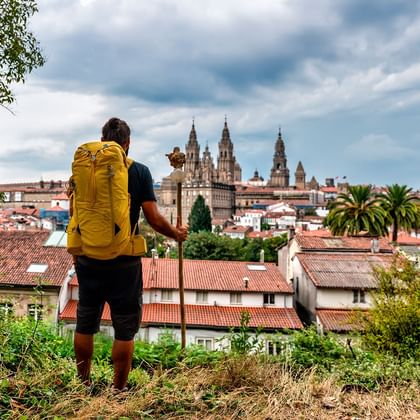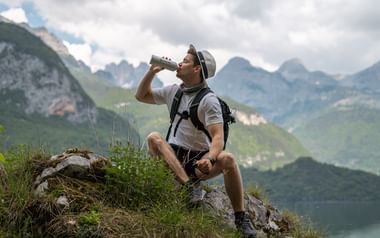Our Tours on The Portuguese Camino
Our Tours on The Portuguese Camino
Why Choose the Portuguese Camino
The Portuguese Camino is a fantastic alternative to the busier French Camino. Here you’ll experience a more peaceful atmosphere and authentic encounters with the locals. It also offers great variety: you can choose the classic central route through Portugal’s lush countryside or the coastal variant with dramatic views of the Atlantic Ocean. At the same time, the infrastructure is excellent, giving you both comfort and freedom on your journey.
History
The Portuguese Camino is one of the oldest pilgrimage routes to Santiago de Compostela. As early as the Middle Ages, believers set out northward from Lisbon and Porto to honor the tomb of the Apostle James in Galicia. The route grew in popularity as kings, nobles, and ordinary people from Portugal joined the great European pilgrimage tradition. Along the way, the path passes through historic towns, medieval churches, and cobblestone roads where centuries of history can be felt with every step.

Traditions and Symbols
Like all Camino routes, the Portuguese Camino is rich in tradition and symbolism. The well-known scallop shell marks the way and is carried by pilgrims as a sign of their journey. Yellow arrows painted on roads and signs guide you safely northward. Many also choose to carry a pilgrim passport (credencial), where you collect stamps along the way – and which allows you to receive the official Compostela certificate in Santiago once you have walked at least 100 km.
For many, the Camino is more than just a hike – it is a personal journey, offering space for reflection, contemplation, and unexpected encounters with fellow walkers from around the world.
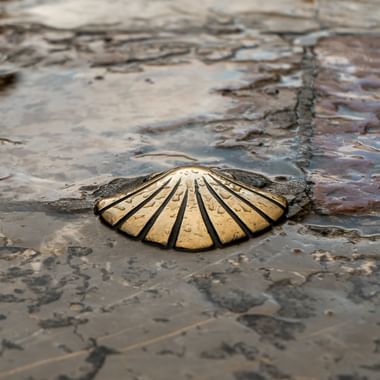
Two Routes and a Twist
The Central Route
The most classic and popular path from Porto to Santiago. It leads through lush landscapes, historic towns such as Barcelos and Ponte de Lima, and along ancient Roman roads. The central route beautifully combines culture, nature, and history.
The Central Route
The most classic and popular path from Porto to Santiago. It leads through lush landscapes, historic towns such as Barcelos and Ponte de Lima, and along ancient Roman roads. The central route beautifully combines culture, nature, and history.
The Coastal Route
For those who love the sea, this route follows the Atlantic coast with dramatic views, sandy beaches, and charming fishing villages. You pass through places like Vila do Conde, Esposende, and Caminha before crossing the border into Galicia.
The Coastal Route
For those who love the sea, this route follows the Atlantic coast with dramatic views, sandy beaches, and charming fishing villages. You pass through places like Vila do Conde, Esposende, and Caminha before crossing the border into Galicia.
The Spiritual Variant
A special detour from the central route after Pontevedra, following the so-called Traslatio – the mythical route along which the remains of the Apostle James were brought by boat. Here you walk via the Monastery of Armenteira and then sail up the Ría de Arousa, creating a unique combination of hiking and boat journey.
The Spiritual Variant
A special detour from the central route after Pontevedra, following the so-called Traslatio – the mythical route along which the remains of the Apostle James were brought by boat. Here you walk via the Monastery of Armenteira and then sail up the Ría de Arousa, creating a unique combination of hiking and boat journey.
Facts about the Portuguese Camino
Overview Map
The Portuguese Camino stretches over several hundred kilometers from Portugal to Santiago de Compostela in Spain. A good map gives you an overview of the different options – from the starting points in Lisbon or Porto to the many exciting stages on the way to the goal in Galicia.
The blue routes on the map represent the Portuguese Camino.

Notable Towns and Highlights
-
Porto – UNESCO-protected historic center, the Douro River, and the famous port wine cellars. A perfect start to the pilgrimage adventure.
-
Barcelos – Known for the colorful rooster, one of Portugal’s most famous symbols.
-
Ponte de Lima – Portugal’s oldest town with a stunning medieval bridge over the Lima River.
-
Caminha – Coastal town at the mouth of the Minho River, close to the Spanish border.
-
Valença/Tui – Impressive fortress towns on either side of the Portuguese-Spanish border.
-
Pontevedra – A charming Galician town with car-free old streets and cozy tapas bars.
-
Padrón – Known as the place where the remains of the Apostle James are said to have arrived by boat.
-
Santiago de Compostela – The iconic cathedral and pilgrims’ square where all routes come together.
No matter which variant you choose, a wealth of cultural, historical, and scenic highlights await along the way.
Distances and Level of Difficulty
The Portuguese Camino is known for being a relatively easy yet varied route. Daily stages typically range from 14–25 km, which suits most walkers with an average level of fitness. The terrain varies from flat coastal stretches and vineyards to gentle hills and cobblestone streets in historic towns.
In general, the Portuguese Camino is considered moderate in difficulty, with only a few steep sections. This makes it an excellent choice for both first-time walkers and more experienced pilgrims who want a comfortable and scenic journey.
With Bering Travel, you can choose between different versions of the tour, so the program matches your fitness level and preferred pace. For example, you can walk the route with longer stages (14 km – 25 km) or opt for one of the easier versions, where the stages are shorter (7 km – 18 km). We always make sure that your luggage is transported from hotel to hotel, so you only need to carry your daypack.

Accommodation on the Camino
-
Albergues: The classic pilgrim hostels are budget-friendly and social. Here you often sleep in dormitories together with other walkers. It’s a great way to meet people from all over the world, but comfort is basic, and beds cannot always be reserved in advance.
-
Guesthouses: Smaller, privately run places with private rooms and often a cozy, local atmosphere. Comfort is better, and it’s possible to book in advance.
-
Hotels: From small, charming village hotels to modern city hotels. These offer private bathrooms, better facilities, and more peace after a day of walking.
Please note: Bering Travel only arranges the tour with hotels, and you will always have a private bathroom/toilet in your room.
Use our app
On our self-guided walking and cycling holidays, you have access to our Bering Travel App. It can be used as a GPS during your trip, making it easy for you to follow the routes and stay on track.

A Camino with Bering Travel
-
We reserve comfortable hotels along the entire route for you, all with private rooms and bathrooms. You arrive at a place where you can rest properly, enjoy a good meal, and sleep safely – ready for the next stage.
-
We arrange daily luggage transport, so your large bag or suitcase is taken from hotel to hotel. You only need to carry a light daypack with water, snacks, and essentials.
-
We select accommodations with excellent locations close to the route and with authentic local charm. You can expect cozy surroundings and friendly service.
-
You get access to the Bering Travel app, which shows you all accommodations, the route, points of interest, and practical tips, making navigation easy – even offline.
In short: With Bering Travel, you enjoy a safe, comfortable, and effortless Camino experience where your only focus is to enjoy the journey – we take care of all the practicalities.
Food & Drink
Portuguese and Galician Specialties
One of the greatest pleasures of walking the Portuguese Camino is the food – as you journey through two countries with proud culinary traditions. From Portugal’s rustic classics to Galicia’s fresh seafood, you’ll enjoy a true culinary journey as part of the experience.
-
Vinho Verde – Light, slightly sparkling, and refreshing white wine, perfect for a lunch break.
-
Bacalhau – The iconic dried and salted cod, prepared in countless ways – à lagareiro (oven-baked with potatoes), à Brás (with potatoes and eggs), or com natas (with cream).
-
Caldo Verde – Traditional vegetable soup with kale and chorizo, ideal on cool evenings.
-
Frango Assado – Juicy grilled chicken, often served with spicy piri-piri.
-
Fresh seafood and fish dishes – Especially on the coastal variant, where you can enjoy everything from grilled sardines to large prawns.
-
Pastel de Nata – The famous crispy, creamy custard tart – a must with your coffee on a café stop.
-
Bifana – A simple but tasty pork sandwich with spiced marinade – perfect for a quick lunch.
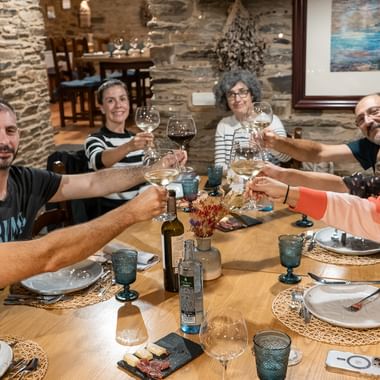
In Galicia (Spain)
-
Albariño Wine – Galicia’s pride, an aromatic and fresh white wine, perfect with seafood.
-
Pulpo a la Gallega – Tender octopus sprinkled with paprika and olive oil, often served on wooden plates in tapas bars.
-
Mariscos – A bounty of seafood: mussels, prawns, and scallops, all freshly caught from the Atlantic.
-
Empanadas Gallegas – Large, filled pies with tuna, meat, or vegetables – perfect for a picnic along the trail.
-
Lacón con Grelos – Salted ham with turnip greens and potatoes – a classic Galician comfort dish.
-
Tarta de Santiago – The iconic almond cake decorated with the cross of St. James – a sweet reward when you reach Santiago de Compostela.
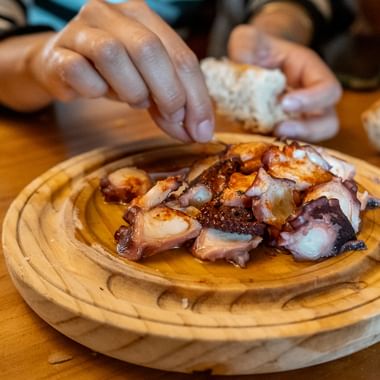
Food and Drink While Walking
On the Portuguese Camino, it’s easy to find food and drink along the way. No matter which route you choose, cafés are never far apart, making the walk itself much more enjoyable.
-
Water – Always bring one or two bottles with you. Water fountains, cafés, and bars are found regularly along the routes. On hot days, it’s important to drink plenty.
-
Snacks – Nuts, fruit, energy bars, or a sandwich in your backpack give you flexibility. It’s nice to take a break whenever it suits you.
-
Cafés and Bars – Small village cafés are part of the experience. Here you can get coffee, fresh juice, a sandwich, or the daily special. Often, they also provide stamps for your pilgrim passport – and just as importantly, a warm welcome from the locals. In the Bering Travel app, you can easily see where the different eateries are located along the route.
-
Opening Hours – Portuguese and Spanish villages may have siesta-like breaks in the middle of the day. Plan your lunch or shopping with some flexibility in mind. Also remember that supermarkets often open after you’ve already started walking, so if you want to stock up, it’s best to do so the day before.
Climate and Seasons
Spring (March–May)
Temperatures are pleasant (typically 15–25 °C), the landscape is green and blooming, and the days are getting longer. It’s an ideal time for those who want to avoid the heat and larger crowds of midsummer. Light rain may occur, but it only adds to the lush surroundings.
Advantages
-
Cool and comfortable walking conditions
-
Beautiful green scenery with wildflowers
-
Fewer people compared to the midsummer season
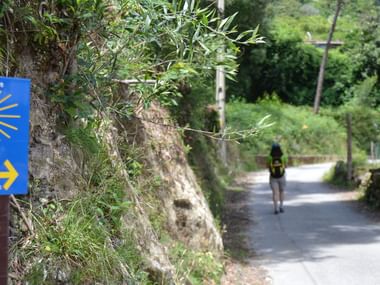
Summer (June–August)
The warmest season, with temperatures ranging from 25–35 °C, especially inland. On the coastal route, it’s cooler and often more breezy. Summer is also when most pilgrims are on the route, creating a lively, social atmosphere – though it can feel crowded in some places. Perfect for those who enjoy the warmth and plenty of company along the way.
Advantages
-
Longest and brightest days
-
Lots of life on the route and in the towns
-
Ideal for those who want to experience the Camino spirit with many fellow pilgrims
-
The coastal route is a great choice for cooler breezes
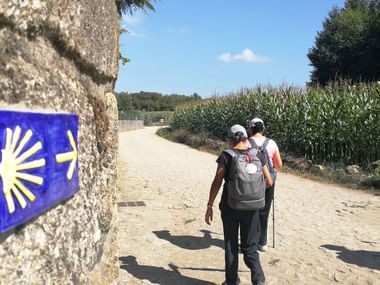
Autumn (September–October)
One of the most popular times of the year. Temperatures drop back to a pleasant 18–25 °C. The vineyards change color, and the harvest brings life and activity to the villages. The chance of rain increases slightly in October, but overall the weather is mild and stable.
Advantages
-
Perfect temperatures for hiking
-
Beautiful autumn colors and vineyards at harvest time
-
Less crowded than July/August, yet with excellent infrastructure still in place
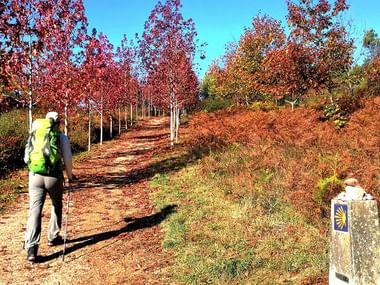
We drive your luggage
On our walking holidays, we want you to focus on enjoying nature and the experiences along the way – without worrying about your luggage. That’s why we offer luggage carrying, making your walking holiday even more comfortable and hassle-free, allowing you to enjoy it to the fullest. Let us handle the logistics so you can focus on discovering new horizons, experiencing nature’s beauty, and creating memories for life. You can always contact us if you have further questions about the luggage service or find information on the specific holiday page.

Preparing for the Portuguese Camino
Packing List
When you book your trip with Bering Travel, you will receive a detailed packing list before departure, but here are the essentials:
-
Daypack (20–30 L): For water, snacks, rain gear, and other daily necessities
-
Footwear: Well broken-in hiking boots or trail shoes, depending on terrain and weather
-
Rain jacket or poncho: Weather can change quickly, especially in spring and autumn
-
Layered clothing: T-shirt, long-sleeve top, fleece or light jacket
-
Sun hat or cap: For sun protection
-
Sunscreen and sunglasses: Important on open stretches
-
Light, quick-drying trousers/shorts
-
Hiking socks: Several pairs – preferably specialized and quick-drying
-
Toiletries: Minimalist – small containers to keep packing light
-
Small first-aid kit: Band-aids, blister plasters, painkillers
-
Pilgrim Passport (credencial): For collecting stamps along the way (provided by us)
-
Phone + charger/power bank: With the Bering Travel app installed
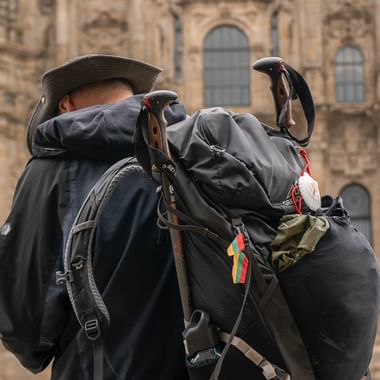
Training for the Journey
Although the Portuguese Camino is generally moderate in difficulty, it still means walking many kilometers day after day. The better prepared you are, the more you will enjoy the experience.
-
Practice with hikes at home: Walk regularly – ideally 10–20 km at a steady pace. Use these hikes to test your gear, such as shoes and backpack.
-
Train on hills: There are ascents along the way, especially in the Minho region and Galicia.
-
Stretching and strength: Simple exercises for legs, back, and hips help prevent soreness.
-
Start in good time: A couple of months of preparation can make a big difference to your comfort on the Camino.
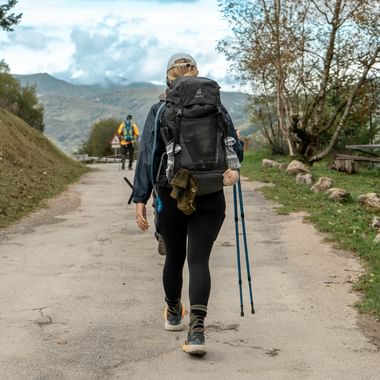
Pilgrim passport on the Camino
You get your passport stamped in all the towns where you stay overnight and when you have enough stamps, you can get your pilgrimage certificate in Santiago de Compostela. Remember that you must have walked at least 100km on the Camino to get your pilgrimage pass.

Frequently Asked Questions about the Portuguese Camino

"We look forward to making your holiday dreams come true"
